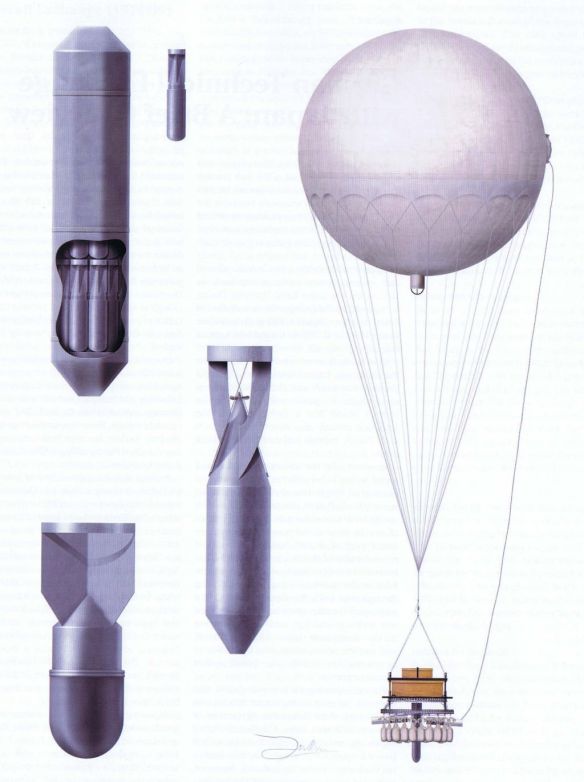The illustrations depict the following weapons, from left to right: canister for the Ta bomb with a Ta bomb beside it, Ko-Dan rubber bomb, Type 99 No. 3 Mk. 3 Sanga and the Fu-Go.
The secret weapons that were developed by the United States against Japan, and vice versa, included some of the most fanciful ever seen in war. The Japanese resolved to launch incendiary attacks against the United States, and manufactured some 9,000 hydrogen balloons to which they fitted small incendiary weapons that could burn for over an hour and 33lb (15kg) of high explosive anti-personnel bombs. The plan was to launch them into the high-altitude jet-stream – which the Japanese had just discovered – so that the weapons were carried across the Pacific to North America. The balloons were made of paper and were assembled by young women, mostly acting students from nearby schools. The washi paper for the balloons was made from large sheets stuck together with ‘devil’s tongue’ gel made by boiling the roots of arum lilies. Virtually the entire stocks of the arum root gel disappeared from the stores, partly to feed the balloon industry, but also because it had a pleasant taste and was being consumed by the students in copious quantities.
Toward the close of 1943 and into the early part of February 1944, the Japanese launched balloons equipped with radios which were tracked so their courses could be monitored. Two stations set up in Hokkaido and in Chiba Prefecture could track the balloons only through the first portion of their flight, but once over the open ocean all con- tact was lost. The Japanese were aware that the west-to-east wind speeds were at their peak from November through to March, topping out at 298km/h (185mph). In addition, a shortage of meteorological data on weather patterns over the ocean and at high altitudes limited the ability to plan trajectories for th balloons. While the winds were higher, it was also winter throughout most of the launch window. In addition, the balloons had to be released in clear, cloudless weather with little surface wind. If balloons were sent up in over- cast skies with precipitation laden clouds, moisture would collect on the balloons which would freeze at higher altitudes, adding weight resulting in the balloons being unable to reach the S. Three major launch ites were selected: Nako 0 (Fukushima Prefecture), Otsu (Ibaraki Prefecture) and Ichin Omiya (Chiba Prefecture).
Starting in November 1944, the Special Balloon Regiment established under the Imperial Japanese Army released a continuous stream of these balloons from Ibaraki Prefecture, on the western side of Honshu. On 3 November 1944, the Fu-Go balloon bombing campaign was officially opened. In all, between 9,000-10,000 balloons were avail- able and by 20 November, the first en masse launchings had taken place. Prior to launch, the sandbag release mechanism was set based on the estimated wind speeds to ensure the balloon was over the US before releasing its payload. The gas envelope was only partially filled to allow for expansion of the hydrogen at an altitude of 4,877m (I6,000ft). On a good day crews could launch up to 200 balloons. March 1945 would see the highest number of balloons deployed, 3,000 in all, and the final launch was made on 20 April. Typically included in batches of balloon launches would be a radio equipped balloon to allow for tracking.
Unlikely as it seems, the ruse worked; most of the balloons burst or deflated, landing in the sea, but over 1,000 of these secret weapons reached North America and a quarter of them caused damage, mostly small forest fires. The first reports of the fireballs descending from the skies were dismissed as farmhand gossip, but towards the end of 1944 the authorities realized what was happening. Some of the balloons landed intact and were examined by the military. The payload contained magnesium as an incendiary device, partly to set fire to the balloons on landing, but also to ensure that the device was consumed in the blaze, so that the Americans would not discover the true nature of these strange balloons.
However, the balloons produced minimal interference with the conduct of the war, and once the nature of the weapons had been discovered, many were shot down by warplanes in mid-flight. A secret agreement was made with newspaper editors, so that reports of successful attacks were never published, and the Japanese could not find out how successful their balloons had been. After five months had passed without any news of damage appearing in the American news media, the Japanese became discouraged and discontinued their attacks. In reality, 285 balloon bomb incidents had been reported and some of the balloons reached as far as Michigan. One was found by a group of holidaymakers in the Oregon woods, all of whom were killed when they tried to move it and the anti-personnel mine exploded.
